|
 |
|
History Of CSI
Central
Kerala Diocese
|
|
The CSI Madhya Kerala
Chapter 1
Chapter 2
Chapter 3
Home /
About
Us
Articles
[ Rev. C.Y. Thomas is an ordained presbyter of the Church of
South India. He was the General Secretary of the
Youth Movement of the Diocese of Madhya Kerala. He was also
Bishop’s chaplain and chaplain of the CMS College, Kottayam. Now he is
the Vicar of CSI parish, Dubai, in Gulf. ]
|
|
|
THE
CSI MADHYA KERALA DIOCESE
by
REV.
C. Y. THOMAS
CHAPTER
1
INTRODUCTION
Kerala,
the State, clothed in nature's finery, protected by the Rocky Mountains
in the East and washed by the waves of the Arabian Sea in the West, has
been blessed with Christianity from the first century. Tradition has it
that it was St. Thomas, the Apostle of Jesus who brought
Christianity to Kerala. The Ancient Syrian Church of Malabar
had links with Christian centers in West Asia. The winds of the
Reformation which rocked Europe in the 16th century swept in India as
well with the coming of the missionaries of the Church Missionary
Society, the London Missionary Society and the Basel Mission.
The
Church Missionary Society (C.M.S.), was a society organized by some
evangelicals of the Church of England on April 12th 1799 to help the
propagation of the Gospel in Africa and in the East. The CMS was of
course, the child of 'Evangelical Anglicanism’ and its original name
was 'The Society for Missions in Africa and the East'. After a few
years, the title "The Church Missionary Society" was formally
adopted.
1. BRITISH CONNECTION
WITH TRAVANCORE
The
origin of Travancore's connection with British goes back to 1685, when
the English East India Company established a factory at Anjengo
in Travancore by obtaining land from the Attingal Rani. The
English established the factory mainly with a view to breaking up the
Dutch monopoly in those parts. Thus a cordial relationship between the
East India Company and Travancore developed. In the second half of the
18th century. the fear of
invasion from Haider Ali and Tipu Sultan, compelled Travancore to depend
for her safety on the English East India Company. In November 1795, a
treaty of perpetual friendship and alliance was signed between the Rajah
of Travancore and the East India Company. The treaty was again modified
in 1805, which established British paramountcy over Travancore.
As
a result of these treaties, the British Residents were henceforth to
represent Great Britain at the Court of Travancore. The first two
residents were Col. Colin Macaulay (1800-1810) and Col. John Munro
(1810-1819), who were protestant Christians of strong convictions;
interested in the affairs of Jacobite Syrians.
|
2. THE C.M.S. IN TRAVANCORE
The
origin of the work of the C.M.S. in Travancore can be traced to the Rev.
R. H. Kerr and the Rev. Claudius Buchanan, who paid visits to the
Malabar Syrians in 1806, during the episcopate of Mar Dionysius1. It was
Lord William Bentinck, who sent Dr. Kerr to Travancore for the purpose
of investigating the state of the native church. E. M. Philip tells us
that, "he (Kerr) expressed to the Metropolitan of the Syrian Church
a hope that one day a union might take place between the Syrian and the
Anglican Church and that he seemed pleased at the suggestion." 1
The
next friendly Anglican visitor was Dr. Buchanan, who evinced a keen
desire that the Syrian Church and the Church of England should be
brought closer together. His speech at the C.M.S. Anniversary in 1809
and his famous book, "Christian Researches in Asia", drew the
attention of the English people to the Syrian Christians of Travancore.
According
to W. J. Richards, a C.M.S. Missionary in Travancore, in the beginning
of 19th century the religious and social conditions of the Syrian
Christians were pathetic. The people were steeped in ignorance and
superstitions. The Jacobite Syrian Church was also at this time at a
very low spiritual level. This is clear in the words of the Syrian
Metropolitan, when he had an interview with Dr. Buchanan in which he
says, "you have come to visit a declining church." 2
3. MISSION
OF HELP TO THE SYRIANS
The
C.M.S. Mission of Help to the Jacobite Syrians of Kerala was started in
the year 1816, of which the initiative came from Col. Munro, the then
British Resident of Travancore. There were two main purposes behind the
Mission of Help to the Syrians. First of all, through the work of the
C.M.S. Missionaries among the Syrians, to effect the renovation of their
Church and to raise them from their degradation. Secondly, the British
Resident as well as the missionaries hoped that, "a strong and
friendly Christian Community will be a support for the British power in
Malabar". Rev. Thomas Norton was the first missionary who came to
Travancore in this connection. He was soon followed by Benjamin Bailey
(1816), Joseph Fenn (1818) and Henry Baker (Sr) (1819) who are popularly
known as the "Kottayam Trio". These three concentrated their
work among the Syrians, where as the pioneer missionary, Norton focused
his work among the outcastes in Alleppey.
The
work of the missionaries among the Jacobite Syrians was mainly on the
education field. Fenn took charge of the college for training the
younger clergy; Bailey devoted himself chiefly to literary and
translation work and the press, while Baker took charge of the parish
schools up and down the land. Though the relationship between the
missionaries and the Jacobite Syrians went on well without many problems
in the beginning, it did not last long. The change of leadership in the
Jacobite Syrian Community as well as the change of missionaries caused
much problem in the relationship. During the second half of the Mission
of Help, the pioneer missionaries went on furlough. While they were away
new men came on the scene, Joseph Peet (1833-1865) and W. J. Wood Cock
(1834-1837). The young missionaries were rather impatient about the slow
progress being made and were sometimes rash in their actions. The visits
of the Rev. J. Tucker, Secretary of the C.M.S. Corresponding Committee
at Madras, and Bishop Wilson, the Anglican Bishop of Calcutta did not
heal the wound, these two being uncompromising evangelists. This was
followed by a Synod of the Syrian Christians at Mavelikkara on 16th
January 1836, in which the Jacobite Syrian Community under Mar Dionysios
IV, the then Malankara Metropolitan decided to break all their
relationships with the Church of England. With this we see an early
death of the twenty-year-old C.M.S. Mission of Help to the Syrian Church
of Travancore.
Was the Mission of Help a failure? An eminent Hindu,
Diwan Bahadur Nagamiah says in the Travancore State Manual that,
"Although the Syrians headed by their Bishop had thus forrnally
parted company with the Church Missionary Society, the teaching of the
missionaries for more than twenty years had not been without result, and
there was among the Syrians a party who was influenced by that
teaching."
3
|

Eastern Kerala
Hill Areas

Periyar Lake
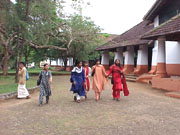
CMS College
in Kottayam
|
|
4. MISSIONARIES
TURN TO THE MASSES.
The
dissolution of the contract between the C.M.S. and the Syrian
Metropolitan after 20 years of beneficial work was no doubt says, C.M.
Agur "a great disappointment” 4With
the snapping of ties, the missionaries directed their attention to the
despised and the downtrodden Ezhavas, Hill Arrians, and the outcastes of
Central Travancore.
Due
to the impact of the work of the C.M.S. among the Syrian Christians,
soon after the separation with them, several Syrian Christians who were
attracted towards the reformation joined the Anglican Church. In certain
cases, the whole Syrian parishes joined with the missionaries.
Therefore, the missionaries began to serve them as parish priests too.5
In
1840, Bishop Spencer of Madras, who succeeded Bishop Daniel Corrie after
his death in 1837, made his first episcopal visit to Malabar soon after
the Archbishop of Canterbury had put the congregations of Travancore
under the Episcopal oversight of the Bishop of Madras. Thus the Anglican
Church was fully established in Travancore in 1840. By 1840's
missionaries started systematic evangelism among the non-Christians,
especially those of the lower classes. In 1848 Baker reported that he baptized
thirty five individuals. He again speaks: "They have been Chogans.
Two I had rescued from slavery very accidentally."6 In
1850, Rev. J. Hawksworth wrote, "The visible success of this
mission during the past half-year has been almost exclusively among the
'heathen" 7
KOTTAYAM
MISSION
Even
before the formal break with the Syrian Christians, the CMS Missionaries
at various places had started work among the non-Christians. After
1836 we find in the C.M.S. records, references to the 'Kottayam Village
Mission' with Bailey in charge of it and 'the Kottayam District Mission'
under Baker, with his headquarters at Pallom, five miles to the South.8
They also continued educational work and built another college at
Kottayam, the C.M.S. College in 1838. The new college made its real
start in 1840 when the Rev. John Chapman took charge of it.
|
|
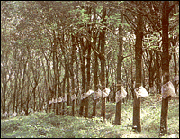
Rubber Plantations
In Kottayam

Periyar Lake
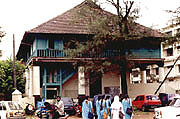
Baker School
in Kottayam
|
The
missionaries were the pioneers in the field of printing. Having acquired
the necessary mastery over Malayalam, Bailey translated and printed two
complete editions of the Holy Scriptures and two of the Common Prayer
Book. Besides these, he wrote a big English and Malayalam Dictionary and
another Malayalam and English Dictionary. In 1848 the first Malayalam
periodical "The Treasury of Knowledge" was published and is
still coming out as the Diocesan Magazine.
In
1843, Bishop Wilson said about the future work of the missionaries as,
"You had no other course to take but to build churches for
yourselves, to go on with your own schools, to multiply copies of the
scripture, to erect, as you have done, your own college, and to carry on
an open unfettered mission for the good of the heathen and Muharnmadans
generally, and of the individual Roman Catholics, Roman Syrians
and Syrians around you who might voluntarily and peaceably avail
themselves of your labours..." 9 Church building was one
of the principal activities of the Kottayam Mission in the forties. At
Mallappally, Kottayam, Pallom, Kollad, Olessa, Ericadu, Changanacherry,
Mavelikkara, and Mundakayam, fairly beautiful churches were built. Of
these, the largest as well as the most beautiful was the Holy Trinity,
Kottayam, which Bishop Wilson called, "the noble Gothic Church, the
glory of Travancore," 10 .
It was the work of Bailey whose laborious service in Kottayam
went on apace, undeterred by the split.
Another
notable contribution of the Kottayam Missionaries was the female
education. The first Mission Girls' school was started in Kottayam by
Mrs. Fenn and Mrs Baker in 1825 or so. It was probably one of the very
first Girls' Schools in India. After Mrs. Fenn's departure it was
carried on by Mrs. Baker with the help of a daughter for sixty years.
Her daughter-in-law and descendents continued the good work for a long
time. The introduction of the system of grant in-aid to private
educational institutions in 1874, helped the missionaries to promote
education to every class of people.11
Kottayam
is the first District in India, to acquire 100 percent literacy,
and this creditable achievement will always be connected with the name
of Baker.
CAMBRIDGE
NICHOLSON INSTITUTION (C.N.I.)
It
was in 1859, that the C.N.I. started to train teachers and mission
workers. It was started as a Vernacular Teachers' Training School. The
teacher-cum-mission workers did a great job for the growth and
development of the Anglican Church in Travancore.
THE
MISSIONARY CONFERENCE
The
Missionary conference was established in 1835 for the efficient and
harmonious management of the affairs connected with the Kottayam
Mission. 12 In 1840 it was called the Travancore Clerical
Association and continued to be the local Governing body of the Mission
until 1st January 1928, when it was finally superseded by the Diocesan
Council.
KOTTAYAM
DISTRICT MISSION
There
were two congregations in Kottayam District - Pallom and Kollad. Henry
Baker Junior carried on vigorously and in 1847 he completed the
construction of churches at Olessa, Velluthuruthy and Ericadu. At the
close of five years' work the membership of the Anglican Church in the
combined districts numbered 552. By this time another district had been
formed at Tiruvalla and Hawksworth was in charge of it.
Rev.
M. J. Chandy was ordained in Madras in 1847 and was the second Malayalee
to receive Anglican Orders, the first having been the Rev. George Mathen
in 1844. In 1856, four more Indian clergy were added to the Anglican
Church. The Annual report for 1856-57 states. "The Travancore
Mission exhibits the best proof of real progress in the fact that native
congregations which have been gathered together by the labors of
missionaries have now been committed to the charge of native
clergymen." By 1870 their number was fifteen.
|
HILL
ARRIAN MISSION
From
1848 onwards, there was a turning point in the work of the C.M.S.
Missionaries, as they began to work among the Hill Tribes of Central
Travancore. The principal tribe among whom the C.M.S. Missionaries
concentrated their work was, the Hill Arrians. This Mission was the out
come of the request of a delegation from among the Hill Arrians to the
C.M.S. Missionary, the Rev. Henry Baker Junior, often been known as the
'Apostle of Hill Arrians.' The deputation of the Hill Arrians
persistently kept on coming. Their eagerness was remarkable. Henry Baker
wrote "The heads of several villages appeared at Pallom
and remonstrated on account of my delay. Five times", said
they "have we been to call you. You must know, we know nothing
right; will you teach us or not? We die like beasts, and are buried like
dogs; ought you to neglect us?" "Cholera and fever" said
another, "carried off such and such members of my family; where are
they now?" They stated that they "wanted no pecuniary
help", as they had plenty of rice. They wished to serve God, and
not to be oppressed by any one." 13. At last Henry Baker
conceded to the request and decided to visit the Hill Arrians in 1848.
The eagerness of the Hill Arrians to be instructed, to some extent
helped the missionary to introduce a self supporting and self
propagating mission from the very beginning.
The
evangelists working under Henry Baker in the plains volunteered to go to
the hills and teach the Hill Arrians. It was they who taught and
instructed them. In 1849 Baker opened a mission with a large campus in a
place named 'Mundakayam', heron's pool, which caused him to be called -a first rate colonizer" by T. G. Ragland, the then C.M.S.
Secretary in Madras.14.
The
missionary earned a large compound for the mission from a landlord and
settled many native families. The jungle had been cleared; eight houses
were built for native families and a schoolroom to be used also as a
place of worship. With the development of the mission, the progress was
visible among the converted Hill Arrians in the socio‑cultural and
religious spheres. These upward developments they had, were not gained
by not paying heavy prices. They had to undergo bitter persecutions and
severe oppositions from their own kith and kin, the communities that
were interested in exploiting them and from the government officials.
From
Mundakayam as a Mission Centre, the work began to extend northwards. In
1852, Baker went on a visit to the villages of Erumapra, Melukavu,
Walakorn. and several others, and reported that, "there is a
complete string of Arrian villages the whole way from this to Mundakayam,
averaging not more than three miles distance from each other." 15.
In 1854, two other villages had also been opened, Kannikal and Puthata.
The Mission on these hills increased day by day. Baker expressed, 'I am
happy to say that my hill people are improving every way..."
Further, he speaks about the vast area of his mission district as
"my district" when he said, "My district is now like a
country, Mundakayarn being thirty-five miles east of Pallom, and
the Melukavu hills, twenty-eight north of that." 16
The abolition of slavery in Travancore helped the
outcastes and the hill tribes to respond to Christianity in large
numbers. In 1853, His Highness, Utram. Tirunal Marthanda Varma Maha
Rajah, by a Royal Proclamation, declared that all future children of
government slaves are free from bondage, and in 1855, the Maha Rajah
completely abolished all kinds of slavery in his dominions.17.
This gave freedom to the slaves to embrace the religion of their choice.
In 1855, the Pallom district was divided. All the hills and a portion of
the country along the foot, about 20 miles wide, with no defined limit
north or south was called the "Mundakayam Church Mission
District." Henry Baker was in charge of the new district. He again
divided the district into two parts, Mundakayam and Melukavu. In the
Melukavu hills there were three congregations at Erumapra, Melukavu and
Kannikal. Similarly, in Mundakayam also there were three congregations,
Mundakayam, Koottickal and Assapian. The members of all these
congregations were steadily increasing. There were schools in each
village at which all the children were required to attend.
Henry Baker raised the status of the two mission stations, Mundakayam
and Melukavu. into the position of pastorates and appointed two native
ministers to look after the missionary work. Besides, for every
outstation there were native readers or evangelists and native teachers
to the schools.
|
|

Peruthenaruvy |
|
|
|
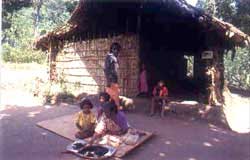
Tribal
House
|

Elephants in Thekkady
|

Athirampal Waterfall |
The missionary also often visited these
stations
and superintended the Hill Arrian Mission.. Under the native leadership,
supervised by the missionary, the Hill Arrians on the whole, all along
the villages continued to be stable and were gradually increasing in
numbers. 18
The following
table clearly illustrates the numerical increase of the converts during
the period from 1848 to 1878.
|
Years
|
1858
|
1868
|
1878
|
|
Baptized Members
|
790
|
1,300
|
2,000
|
|
Communicants
|
65
|
400
|
No.
of communicants not available.
|
In
1878, 'the arduous missionary, Henry Baker Junior, died leaving a legacy
of eleven churches and twenty-seven schools, which he founded in those
hills. With this, the history of the Hill Arrian Mission takes a new
turn.
|
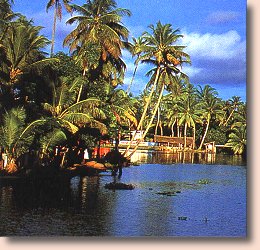
|
|
ALAPUZHA
MISSION
The first Anglican Missionary to arrive in Travancore
was the Rev. Thomas Norton who settled at Alappuzha in 1816 at the
suggestion of Col. Munro. Norton was happy to be at Alappuzha, outside
the Syrian sphere, so that he might concentrate his evangelistic efforts
on the medley of races and religions in that commercial town. The Sunday
after his arrival, he preached significantly on the parable of the grain
of mustard-seed at the first Anglican service held in Travancore.
The beautiful church was completed in July 1819. And in the meantime he
had gained sufficient mastery over Malayalam "to lay myself out in
the delightful work of making known a Saviour's love". The
"laying out" was so effective that when he died in 1840 the
Church was well established, the membership numbering 560 drawn from all
classes.
Norton started
several schools in Alappuzha. About 15 years after his arrival, there
were eleven schools with 301 boys and 57 girls. Two of them were
boarding schools, one for boys and the other for girls under the
supervision of Mrs. Norton. The mustard seed had sprouted. Four days
after Norton's death the Rev. John Hawksworth arrived from England, with
Mrs. Hawksworth, and took charge of the mission. They remained there
until 1845, when they were transferred to Mavelikara and the Rev. Henry
Baker (Sr.) replaced them in Alappuzha. In 1842, the then Bishop of
Madras, during his visit, confirmed 122 persons and described Alapuzha
as inhabited by ‘almost every kindred and tongue and people and nation'.19
THE
COCHIN MISSION
The first missionary to be stationed at Cochin was
the Rev. Thomas Dawson. But he had to return home early in 1818 on
account of ill‑health. In 1820 the Kottayam. Missionaries were
paying regular visits to Cochin every fortnight. Services were held in
the fine old Church of St.Francis 20
which Dawson has repaired.
The work of evangelization gathered prodigious momentum with the arrival
of the Rev. Samuel Risdale in 1824. He threw himself heart and soul into
the work among a very mixed population comprising Indian, Portuguese,
Dutch and English elements. He obtained a grant of land from the
government and gathered a little Christian village around him. A boys'
school and a girls' school were soon started. Risdale had a number of
converts, the most notable of whom were John and Constantine. John was a
Brahmin, and Constantine was Rama Varma, the son of Vira Kerala Rajah.
In 1836 he had opened six outstations namely, Kunnamkulam, Pazhani,
Kandanadu, Truppunithara, Kuttatodu and Chalakkudi. During the year,
Risdale returned home leaving the Rev. Henry Harley in charge. The
latter began to erect a Church at Trichur in 1840 and the next year set
up the headquarters of the Cochin Mission there. Harley did most
distinguished work in Cochin State for more than 20 years.
|

|
Back-waters
|
|

|
 |
Alleppey
Chinese Fish nets at Cochin |
MAVELIKARA
MISSION
Mavelikara became a C.M.S. station when the Rev.
Joseph Peet took up his abode there with his family. Peet did not
perhaps have the erudition of Fenn, the prudence of Bailey or the
patience of Baker. He was a man of action, a born fighter always ready
with the sword of the spirit to jump into the fray and take on every
one.
Within a few months of his arrival at Mavelikara, he had built a church
designed to hold 400 people, and at the end of five years there were
four congregations - Mavelikara, Poovathoor, Kodukulanji and Mallappally, with a membership of about 500. He started seven schools
which had 200 students on their rolls. Whenever he preached his hearers
numbered two to three thousand. "I have hardly ever seen such
earnest and attentive hearers," said Bishop Wilson who visited
Mavelikara in 1845. 22
Peet went home on furlough and Hawksworth took his place in 1845.
Persecution raised its ugly head again as soon as Peet vanished from the
scene. His return was hailed with joy by the rich and the poor alike.
The great missionary labored on in Mavelikara right into the sixties.
The Rev. Joseph Peet rested from his labors at Mavelikara on August 11,
1865. When he died at the end of thirty years' unremitting toil, he was
in charge of eleven substantial churches with members totaling more than
2500.
THE MALLAPPALLY
MOVEMENT
Mallappally has a place of honor in the history of the Mission.
Mallappally was the first non-convert (Anglo-Syrian) congregation.
Rev. George Mathen was the first Malayalam clergyman of Anglican Church.
He ministered to the Mallappally people. The Missionary who did most to
foster the movement in its infancy was the Rev. John Hawksworth. He
wrote to the committee in the early part of 1851 as, "For some
months past there has been a very hopeful movement among the poor slaves
in the neighborhood of Mallappally. In this country these poor creatures
are regarded by the higher classes, and even by common coolies, as
utterly unclean and polluting.23
A school room was erected at
a place called Kaippatta. Mr. Mathen was the schoolmaster. The slaves
heard and received the word of God with great joy. Among the slaves, one
of the first to be baptized was named Abel, which had taken place in
1854. There were thirty desiring baptism, but only eight were admitted.
This Kaippatta incident caused a great excitement in Mallappally. The
barber and the washer man refused to work for the Rev. George Mathen and
the members of his congregation, who were deemed defiled by the
admission of outcastes into their church.
Despite persistent persecutions, slave schools were
opened in several places and the movement spread, gathering momentum
with each new step. It is recorded that nine years after the first
baptisms the Bishop of Madras visited the Mass Movement area and
confirmed over a thousand outcaste Christians. 24
TRAVANCORE CHURCH COUNCIL
The council system of Travancore was developed by
Henry Baker at the instigation of Henry Venn, the C.M.S. Secretary (1841
- 1872) in England. Henry Venn was widely known for his views on the
growth of an independent Native Church. For this object he published his
notable three self-formula; self-support, self-extension and self-administration,
through which he proposed a scheme of appointing a local school-master
in charge of a congregation, after its establishment. 25 Then
the formation of a pastorate, consisting of several congregations under
an ordained native paid from the Native Church Fund. The pastorate was
placed under a district conference or council, which would be setup. In
1869, "The Travancore Native Church Council was formed" 26
and Henry Baker was selected as its first Chairman and the Rev. R. H.
Maddox, Secretary and Treasurer. In 1872 a second Church Council was
organized, and the two councils, one for North Travancore, meeting at
Kottayam and the other for South Travancore meeting, at Mavelikara were
linked by a Provincial Council .27 But, the Mundakayarn
Mission District was not incorporated into this council system. This new
system of church organization helped the mission to grow from 'Mission
to the Church'.
History
of Madhya (Central) Kerala Diocese....
Contd......
Chapter
1 Chapter
2 Chapter
3
|
Bibliography
Chapter 1
|
|
|
|
|
1.
E.M. Philip, 'The Indian Churches
of St. Thomas', 1907 p. 269
2.
W. J. Richards, "The Reforming Syrians of Travancore and
Cochin," CMI, March 1895, P. 183
3.
150 years of Service, CMS p.7
4.
C.M. Agur, Church History of Travancore, Madras, p.99
5.
Ten Brink. "The CMS
Mission of Help." p.239
6.
'Kottayam Village District" Proceedings of the CMS 1848-'49,
p.CXXXV11
7.
lbid; p.CXXXVIII
8.
W.S. Hint, “The Anglican Church in Travancore and Cochin,” Vol-II,
p.2
9.
150 years of Service, The Third Jubilee of the Church Missionary
Society, p.8
10.
W.S. Hint, "Anglican Church in Travancore and Cochin" Vol. 11,
p.42
11.
A. Sreedhara Menon, A Survey of Kerala History', p.332
12.
W.S. Hint, 'The Anglican Church in Travancore and Cochin' Vol-11, p.7
13.
Henry Baker, "The Hill
Arrians of Travancore" p.12
14.
T.G. Ra‑land to Rev. J. Tucker, Letter, MS, dated Quilon, January
14, 185 1, CMSA.
|
|
15.
Letter of Henry Baker dt. 9th Dec. 1852, Proceedings of the.CMS, 1852-1853,
p. 130
16.
Kottayarn and Pallom Districts", Proceeding of the CMS 1853-1854,
pp 119, 120.
17
P. Shangoonny Menon, 'History of Travancore from the Earliest Times',
p.477
18
"Kottayam, Pallom and Mundakayam Districts", Proceedings of
the CMS, 1873-1874, p. 142
19
W.S.Hunt, 'The Anglican Church in Travancore and Cochin,' Vol. 1, p. 149
20.
St. Francis; The church under Franciscan order was built by the
Portuguese and finally taken over by the British and converted into a
Protestant Church
21.
W.S. Hunt, "The Anglican Church in Travancore and Cochin" Vol.
1, P.162
22.
150 years of service, CMS, P. 12
23.
W.S. Hunt, "The Anglican Church in Travancore and Cochin" Vol.
1, P.200
24.
150 years of service, CMS, P. 15
25.
Eugene Stock, 'History of the Church Missionary Society, Vol1, pp. 367-381
26.
W.J. Richard; Twenty years' CMS work in Travancore and Cochin 1858-1878,
p. 10
27.
M F Gibbs The Anglican Church in India 1600-1970, p. 255
|














